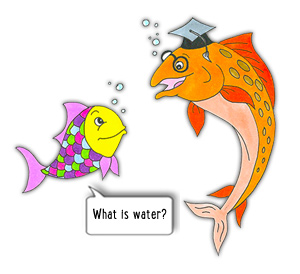Why You Can't Understand People Without Understanding Hypnosis
As well as feeling, doing, thinking creatures, we are hypnotic ones. Understanding this unlocks many mysteries of human behaviour.

"The unconscious mind is decidedly simple, unaffected, straightforward and honest. It hasn't got all of this facade, this veneer of what we call adult culture."
- Milton H. Erickson
Life can be confusing. Why did they do that? Why do I feel this?
Some of the mysteries of life will be revealed to you once you come to see the roles naturally occurring hypnotic trance plays in your - and everyone's - life. In a sense, until we come to understand the central role hypnosis plays in everyday psychology, we remain like the young fish in the following tale.
The young fish and the wise salmon
Once there was a wise old fish. He was constantly dispensing wisdom - about different types of currents, the way water flow varied, how water temperature could change. In fact, what he didn't know about water apparently wasn't worth knowing.
The young fish were very impressed by his water wisdom. But there was one thing they didn't understand. Eventually the bravest of them was selected to ask the sagacious salmon the question that had bothered them all.
"Oh wise one, may the shine on your scales never lose their lustre. We have much enjoyed and undoubtedly profited from your wise words on water. But one question occurs to us as we swim about..."
"Oh really? And what is that, my child?"
"Well, we have listened to you intently, but we would all like to know... what is this mysterious substance 'water' that you talk of, and where can we find it?"
What is hypnosis and where can we find it?
Hypnosis is all around us. It's a central and natural part of human experience, whether we appreciate this or not. Because it's natural, of course it doesn't only happen when we, say, go visit a hypnotherapist or listen to a hypnosis audio.
Hypnosis occurs in all kinds of ways, and it can harm or help us. We are hypnotic creatures, just as fish are aquatic creatures.
So what occurs during hypnosis, how can we define it, and how can we relate this to everyday experience?
The trances of life
When you enter a hypnotic state:
- You narrow your focus (either inwards or outwards)
- Your unconscious mind becomes active and can be greatly opened to learning (good or bad, conscious or unconscious).
- You experience disassociation.
- The creations of your imagination may become more real to you than the external environment.
- You may experience some hypnotic amnesia once your mind shifts to a more diffuse outward focus with more conscious input.
You may believe you've never been hypnotized, but if you've ever dreamed, worried, become enraged, fallen in love, or been in shock, then you have already experienced natural hypnosis.
Consider what happens when you dream.
Your deep nightly trances
Each night you dream. In fact, the average person spends around six solid years of their life dreaming. During this time:
- You are in bed (usually), but your focus is narrowed and directed inwards.
- Your unconscious mind is writing the screenplay (as it were), producing, directing, and starring in the dream. The conscious mind has little if anything to do with the process.
- You are disassociated from your bedroom, and perhaps life in general. You forget for a while where you actually are and are more connected to your inner experience.
- Because this kind of naturally occurring hypnotic state is inward-focused, you are living the dream through the contents of your imagination.
- Because waking up and becoming conscious propels you into a really different state of mind and body than your dream state, you may experience some natural hypnotic amnesia for the dream, either permanently or perhaps until something reminds you of the dream later in the day.
If we think about what defines hypnosis, we can see that dreaming is a deeply entranced hypnotic state.
Rapid eye movement (REM) is associated with both dream sleep and hypnotic waking states. During shock and therapeutic hypnosis, eyelids can often be observed exhibiting REM as well as other components of the dreaming experience, such as activation of the imagination, disinterest in or loss of focus on external reality, and even catalepsy, in which the body becomes really still.
Natural hypnosis occurs in many other ways too.
How hypnosis is happening all the time
When we purposefully hypnotize someone, we simply utilize their natural capacity to narrow their focus, disassociate from their surroundings for a while, activate their unconscious mind and imagination, and learn.
Hypnotic trance is a continuum, meaning you can be deeply hypnotized (perhaps by a dream as you sleep, or by a hypnotherapist) or more lightly hypnotized, as when you're so absorbed in a TV show that you hear but at the same time don't hear someone calling your name.
Putting one another in trance is as old as humanity. When we tell a child (or an adult) a story, we may cause them to some extent to disassociate and forget their surroundings, narrow their focus of attention inward, activate their imagination, and respond emotionally (unconsciously). So storytelling can certainly be used as a means of inducing trance. But there are also ways we hypnotize ourselves.
A person who is prone to worry might be said to be habitually self-hypnotizing by focusing inward and narrowing that focus onto their imagination. When we worry, we are in our heads and less attuned to the reality outside. So worrying requires some level of disassociation.
Another central feature of hypnotic trance is how suggestible it makes us. When entranced, we can become wide open to learning. If I keep worrying that I will make a total mess of an upcoming speech I have to give, I am teaching my unconscious mind to automatically respond with anxiety and disempowerment when the big day actually arrives.
Because trance can happen spontaneously and in everyday life, then, unless we understand the hypnotic mind, we may learn to fear, hate, or be addicted - but equally, we may learn to sing, love, and relax. Strong emotion catapults us into naturally occurring hypnotic states, for better or for worse.
Understanding this helps us see how we can all too easily become conditioned through emotion.
Powerful emotions are powerfully hypnotic
Strong emotions are hypnotic because they:
- Narrow your focus of attention. When you are enraged you only focus on what you are enraged about, perhaps by playing it over continually in your imagination.
- Cause you to disassociate. Someone may be so angry they 'forget' surrounding people can hear them shouting. Someone may be worrying so much that, in the moment, they are more attuned to the contents of their imaginings than external reality.
- Make you suggestible by activating your unconscious mind. If we have been terrified once in the presence of a spider, then we have learned to be more easily terrified by it in future. Some leaders use this to their advantage, trying to raise the emotional temperature in order to make us believe certain things.
- After strong emotion there may be an element of hypnotic amnesia as when people become enraged and then fail to recall what they did or said in the 'heat of the moment.'
We use hypnosis to help with emotional problems because emotional problems are essentially hypnotic conditions. It's truer to say that anger or phobias are triggered unconsciously by stimuli in the environment (post-hypnotically) than to say they are caused by faulty thinking.
Trying to deal cognitively (working to change your thoughts) with a condition that was caused hypnotically may be slow or ineffective.
So how does hypnosis glue emotional conditioning in place?
Pattern matching: how you make sense of life
When something happens in the world around you, your brain tries to instantly match this new experience to something you've experienced before so that, hopefully, you can respond appropriately. But usually this process, known as pattern matching, isn't conscious.
When you see a word you learned long ago, your brain matches that block of ink to a meaning in your mind - a pattern match occurs.
When it's time to eat - when you smell food - you salivate in preparation. The smell of food acts as a kind of post-hypnotic trigger to which your unconscious mind produces a response. An external pattern has triggered a (useful) internal pattern.
But sometimes your pattern matching isn't useful, and can actually cause problems. This is known as 'faulty pattern matching' and occurs with phobias, addictions, compulsions, sometimes depression, and even sexual fetishes. An inappropriate pattern of response, such as fear or desire, gets wheeled out in response to a certain pattern in the environment.
I helped a man who had been a soldier in Afghanistan. He had seen a friend killed by a roadside bomb. Now, back in England, whenever he heard fireworks or unexpected loud noises he would hypnotically regress to that time in Afghanistan. It is no surprise that the people most prone to developing post-traumatic stress disorder may be the most naturally hypnotic people.1
A stage hypnotist may suggest someone sing every time they hear a certain word. He or she has hypnotized the person, then suggested an entirely useless pattern match. The performer has focused their subject's attention and given instructions to their unconscious mind for a bizarre post-hypnotic response or pattern match,so that the person now exhibits that pattern match (for the duration of the show).
The extent to which our pattern matching works effectively corresponds to how 'well adjusted' we are to life.
How to be well adjusted
The more you can use hypnosis in ways that help you meet your intrinsic emotional needs, the happier and healthier you become.
When we understand trance and actively undo the effects of negative emotional conditioning, we can notice effects of unconscious pattern matching that are less obvious than phobias and post-traumatic stress disorder.
Here are some less obvious examples of conditioning and pattern matching:
- Fearing challenges and opportunities because of negative conditioning in your upbringing
- Fearing the prospect of a new relationship because of a past one that was abusive (this may put a serious block on the primal need for intimacy)
- Feeling so angry at a certain person that just the mention of their name acts as a post-hypnotic trigger to instantly become angry.
Good pattern matching is essential for existing effectively in the world, but can go wrong in all sorts of ways. Because pattern matching is naturally hypnotic, we can use hypnosis to treat conditions like phobias, addictions, and anger.
We live within an ocean of trances. Learning to see how trance operates and how we can use trance to make our lives better can make wise salmons of all of us.
You can learn how hypnosis works with our free online self-hypnosis course.






